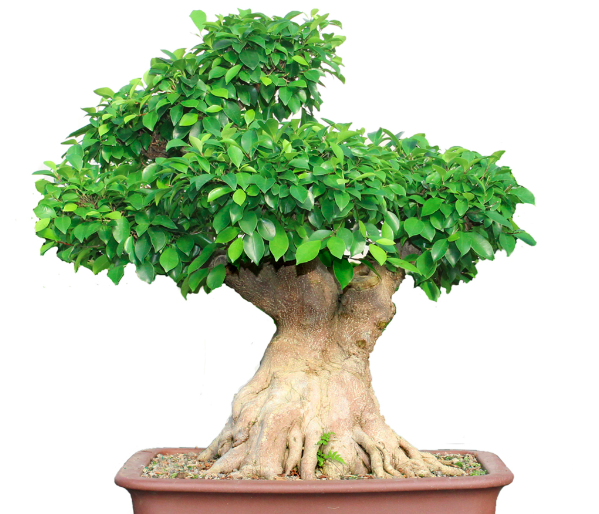
“Creating Ficus Retusa Bonsai”.

Creating a bonsai from Ficus Retusa, commonly known as the Chinese Banyan or Indian Laurel, can be a rewarding and enjoyable process. Here are some guidelines to help you get started:
Selecting a Ficus Retusa:
When selecting a Ficus Retusa for bonsai, there are several factors to consider to ensure you choose a healthy and suitable candidate. Here's a guide to help you make an informed selection:
Health:
- Choose a Ficus Retusa that appears healthy and vibrant. Look for lush green foliage, and avoid plants with yellowing or wilting leaves.
- Inspect the tree for any signs of pests or diseases, such as discolored spots, webbing, or unusual growths.
Trunk and Nebari (Root Flare):
- Examine the trunk for interesting features such as movement, taper, and surface texture. A thicker base tapering gradually toward the apex is generally desirable.
- Check for a well-defined nebari (root flare at the base). A good nebari enhances the overall aesthetic of the bonsai.
Branch Structure:
- Look for a Ficus Retusa with well-developed branches. Consider the existing branch structure and whether it aligns with the bonsai style you envision.
- Ensure that branches are evenly distributed around the trunk to promote balance.
Roots:
- Inspect the roots if possible. A healthy root system is crucial for the long-term success of the bonsai.
- Avoid trees with circling or girdling roots, as these can lead to future health issues.
Details on "Taking Care of Cactus (Cacti)".
Size and Age:
- Consider the size and age of the Ficus Retusa about the bonsai style you have in mind. Younger plants are more flexible for shaping, while older plants may have more developed features.
Container and Soil:
- Check the condition of the current container and soil. A well-draining bonsai soil mix is preferable.
- If the plant is root-bound, it may require repotting, which can be a consideration for your plans.
Season:
- The best time to shop for bonsai is typically during the growing season (spring through early fall). This allows you to assess the tree's health and vitality when it's actively growing.
Local Climate:
- Consider the local climate in your area. Choose a Ficus Retusa that suits your climate conditions well to ensure easier care and adaptation.
Personal Preference:
- Bonsai is an art, and personal preference plays a significant role. Choose a Ficus Retusa that appeals to you aesthetically and aligns with your vision for the bonsai.
Ask Questions:
- If you're purchasing from a nursery or bonsai specialist, don't hesitate to ask questions. Inquire about the plant's care history, known issues, and specific care recommendations.
By carefully considering these factors, you'll be better equipped to select a Ficus Retusa that has the potential to thrive as a beautiful and well-formed bonsai. When it comes to bonsai trees, patience and attention to detail are crucial for their selection and care.
Potting and Soil:
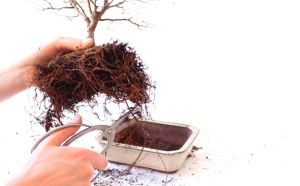
Potting and soil are crucial aspects of bonsai cultivation, and they significantly influence the health and development of your Ficus Retusa bonsai. Here are guidelines for potting and selecting the right soil:
Potting:
Pot Size:
- Choose a bonsai pot that complements the size and style of your Ficus Retusa. The pot should be proportional to the tree's trunk diameter and overall size.
- Bonsai pots with good drainage holes are essential to prevent waterlogging.
Repotting Schedule:
- Ficus Retusa generally benefits from repotting every 2-3 years, typically in spring. Repotting is a beneficial process for plants as it helps to refresh the soil, prune the roots, and encourage new growth.
Root Pruning:
- During repotting, carefully prune the roots to maintain a balanced root system. Remove any circling or girdling roots to prevent future problems.
- Trim back long roots and consider the overall health of the root system.
Soil Surface:
- After repotting, level the soil surface and water the bonsai thoroughly. Avoid burying the trunk deeper than it was in the previous pot.
Secure Anchoring:
- Ensure that the bonsai is securely anchored in the pot to prevent movement. To keep the tree in place, you can use either wires or mesh.
Post-Repotting Care:
- Place the newly repotted Ficus Retusa in a shaded area for a few weeks to allow it to recover. Gradually reintroduce it to its normal growing location.
Soil:

Well-Draining Mix:
- Ficus Retusa requires a well-draining bonsai soil mix. A common mix includes components like akadama, pumice, and lava rock in varying proportions.
- Good drainage is essential to prevent root rot, a common issue with ficus varieties.
Astonishing Medical Advantages of Consuming Cactus Blossoms
Particle Size:
- Use a mix with a variety of particle sizes. This promotes aeration and water retention while preventing compaction.
- Larger particles allow for good drainage, while smaller particles retain moisture.
Organic Matter:
- Including a small amount of organic matter, such as pine bark or coconut coir, provides nutrients and helps with water retention.
- However, be cautious not to use too much organic material, as it can lead to compacted soil.
pH Level:
- Aim for a slightly acidic to neutral pH level in the soil (around 6.0 to 7.0). Most Ficus species, including Ficus Retusa, prefer slightly acidic conditions.
Fertilizer Addition:
- Some bonsai enthusiasts add slow-release fertilizers to the soil mix during repotting to provide nutrients gradually over time.
- Regular fertilization during the growing season is still necessary.
Monitoring Moisture:
- Regularly check the moisture level in the soil. Ficus Retusa prefers slightly moist conditions but does not tolerate waterlogged soil.
Remember that the potting and soil requirements may vary depending on the specific needs and conditions of your Ficus Retusa bonsai. Regular observation and adjustment of your care routine will contribute to the overall health and vitality of your bonsai tree.
Pruning and Wiring:
Pruning and wiring are essential techniques in bonsai cultivation, helping shape and refine the form of your Ficus Retusa bonsai. Here's a guide on how to approach pruning and wiring for your bonsai:
Pruning:

Purpose of Pruning:
- Pruning serves several purposes, including shaping the tree, controlling its size, encouraging branching, and maintaining overall health.
Tools:
- Use sharp and clean bonsai pruning shears or scissors. This ensures clean cuts and minimizes stress on the tree.
Pruning Techniques:
Maintenance Pruning:
Regularly remove unwanted shoots and leaves to maintain the desired shape.
Pinching:
Pinch back new growth using your fingers or shears to encourage ramification (branching).
Thinning:
Remove excess branches to allow light and air penetration. This promotes inner growth and maintains an open structure.
Timing:
- Perform maintenance pruning throughout the growing season, especially during spring and summer when the tree is growing.
- Avoid heavy pruning during late fall and winter when the tree is in a dormant or semi-dormant state.
Branch Selection:
- Choose the main branches that contribute to the overall design of the tree. Remove branches that disrupt the desired silhouette or balance.
Leaf Reduction:
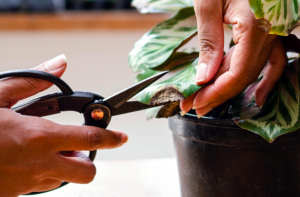
- Ficus Retusa leaves can be large. To reduce leaf size, regularly prune back new growth. This encourages the development of smaller leaves over time.
Wound Treatment:
- After pruning, apply cut paste or sealant to larger wounds. This helps prevent infections and aids in the healing process.
Wiring:
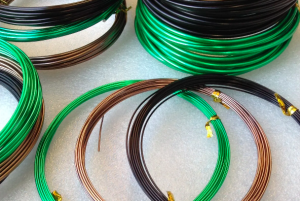
Purpose of Wiring:
- Wiring allows you to shape and position branches and the overall structure of your bonsai. It is a crucial technique for creating the desired form.
Tools:
- Use aluminum or copper bonsai wire. Copper wire is stronger but can leave marks on the bark if not removed promptly. Aluminum wire is more forgiving and is suitable for beginners.
- Wire cutters are essential for safely removing the wire without damaging the tree.
Techniques:
Single Wiring:
Use a single wire to guide a branch's movement.
Double Wiring:
Use two wires in a crossed pattern for added stability and control.
Guy Wiring:
Attach wires to the trunk or other branches to pull or anchor a branch in a specific direction.
Timing:
- Wiring is typically done during the growing season when the branches are pliable. Avoid wiring during periods of dormancy.
Avoid Wire Bite:
- Regularly check the wired branches for wire bite, which occurs when the wire cuts into the bark. Remove or adjust the wire if you notice this happening.
Wire Removal:
- Leave the wire on for the appropriate amount of time (usually several months). Remove the wire before it starts cutting into the bark.
- If the branches haven't been set in the desired position, you may need to rewire.
Details on "Taking Care of Cactus (Cacti)".
Wiring Safety:
- Be gentle to avoid damaging the branches. Ficus species, including Ficus Retusa, have relatively soft wood, so be cautious not to cause injury.
Remember that both pruning and wiring should be done with the long-term vision of the bonsai in mind. Regular observation and adjustment are key to achieving the desired form and maintaining the health of your Ficus Retusa bonsai.
Watering:
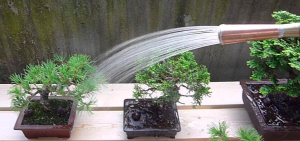
Proper watering is a crucial aspect of Ficus Retusa bonsai care. Here are some guidelines to help you maintain optimal soil moisture levels for a healthy and thriving bonsai:
Observation:
- Monitor the moisture content of the soil regularly. Stick your finger into the soil up to the first knuckle, and water when the top layer feels slightly dry.
Water Quality:
- Use water that is free from harmful minerals and contaminants. If your tap water is hard or contains chlorine, consider using filtered or distilled water.
Watering Frequency:
- Ficus Retusa prefers slightly moist soil. Water when the top layer of soil feels dry to the touch. The frequency will vary depending on factors like temperature, humidity, and the size of the pot.
Seasonal Adjustments:
- Adjust your watering routine based on the season. During the growing season (spring and summer), Ficus Retusa may need more frequent watering than during the dormant period (fall and winter).
Watering Technique:
- Water the bonsai thoroughly, allowing water to soak through the entire root ball.
- Ensure that water reaches the bottom of the pot to encourage deep root growth.
Avoid Waterlogging:
- Ficus Retusa does not tolerate waterlogged soil. Ensure that the pot has adequate drainage holes, and remove excess water from the saucer beneath the pot to prevent roots from sitting in standing water.
Humidity Considerations:
- Ficus Retusa benefits from moderate to high humidity. In dry climates or during winter when indoor heating reduces humidity, consider using humidity trays or placing the bonsai near a humidifier.
Drip Trays:
- Use drip trays under the bonsai pot to collect excess water. This helps maintain a clean and tidy appearance and prevents water damage to surfaces.
Morning Watering:
- Watering in the morning allows the foliage to dry during the day, reducing the risk of fungal diseases.
Leaf Misting:
- Misting the leaves occasionally can help increase humidity, especially in dry indoor environments. However, avoid misting excessively, as Ficus Retusa prefers well-draining conditions.
Reduce Watering in Dormancy:
- During the dormant period, reduce the frequency of watering, as the tree's water requirements decrease.
Emergency Checks:
- If you suspect overwatering or poor drainage, check the roots for signs of root rot (yellowing, mushy roots). Adjust your watering schedule accordingly.
Outdoor Considerations:
- Outdoor Ficus Retusa bonsai may require more frequent watering, especially during hot and windy conditions.
Consistency is Key:
- Establish a consistent watering routine, but always be flexible and adjust based on the specific needs of your bonsai.
By giving close consideration to your Ficus Retusa bonsai's dampness needs and changing your watering routine appropriately, you can assist with guaranteeing the well-being and imperativeness of the tree. Remember that each bonsai may have unique requirements, so observe how your tree responds to different conditions.
Light and Temperature:
Light and temperature are critical factors in the health and development of your Ficus Retusa bonsai. Here are guidelines to help you provide the right conditions for optimal growth:
Light:
Indoor vs. Outdoor:
- Ficus Retusa can be grown both indoors and outdoors. However, they typically thrive with more natural sunlight outdoors.
Outdoor Light:
- Place outdoor Ficus Retusa in a location with bright, indirect sunlight. They can tolerate some direct sunlight, but protection from intense midday sun is advisable, especially in hot climates.
Indoor Light:
- If grown indoors, place the bonsai near a south or west-facing window to receive sufficient light. Alternatively, provide supplemental artificial light using fluorescent or LED grow lights.
Astonishing Medical Advantages of Consuming Cactus Blossoms
Light Duration:
- Ficus Retusa benefits from 6 to 8 hours of light per day. Adjust the exposure based on the specific needs of your tree and local conditions.
Rotate the Bonsai:
- Rotate the bonsai regularly to ensure that all sides receive uniform light exposure. This forestalls lopsided development and empowers adjusted advancement.
Watch for Signs of Insufficient Light:
- If the tree is not receiving enough light, you may notice elongated stems, sparse foliage, or leaves turning pale. Adjust the lighting conditions accordingly.
Temperature:

Temperature Range:
- Ficus Retusa prefers temperatures above 60°F (15°C). They can tolerate a wide range of temperatures, but prolonged exposure to temperatures below 50°F (10°C) can lead to stress and damage.
Winter Care:
- Protect Ficus Retusa from cold drafts and extreme temperature fluctuations. If the bonsai is kept outdoors, consider bringing it indoors or providing winter protection when temperatures drop.
Indoor Temperature:
- Maintain a consistent indoor temperature for indoor-grown bonsai. Ficus Retusa adapts well to typical indoor room temperatures but may benefit from slightly warmer conditions.
Avoid Drastic Changes:
- Sudden temperature changes can stress the bonsai. Gradually acclimate it to new conditions, especially when moving it between indoor and outdoor environments.
Humidity:
- Ficus Retusa prefers moderate to high humidity. Indoor environments, especially during winter with heating, can be dry. Use humidity trays or a humidifier to maintain adequate moisture levels.
Protect from Extreme Heat:
- Shield the bonsai from extreme heat, especially if kept outdoors. Provide shade during the hottest parts of the day to prevent leaf burn.
Monitor in Winter:
- Keep a close eye on your Ficus Retusa during the winter months. If kept outdoors, protect it from frost, and if indoors, ensure it receives sufficient light despite the reduced daylight hours.
By paying attention to light exposure and temperature conditions, you can create an environment that promotes the well-being and development of your Ficus Retusa bonsai. Regular observation of your tree's response to its surroundings will help you fine-tune these factors for optimal results.
Fertilizing:
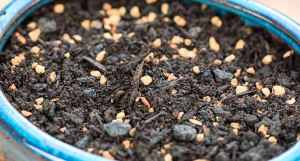
Fertilizing is a crucial aspect of Ficus Retusa bonsai care, providing essential nutrients for healthy growth and development. Here are guidelines for fertilizing your Ficus Retusa bonsai:
Fertilizer Types:
- Use a balanced, water-soluble fertilizer designed for bonsai or general-purpose use. A balanced fertilizer contains equal amounts of nitrogen (N), phosphorus (P), and potassium (K), such as a 10-10-10 or 14-14-14 ratio.
Frequency:
- Fertilize your Ficus Retusa during the growing season, typically from spring to early fall. Reduce or stop fertilization during the dormant period in late fall and winter when growth slows down.
Application Rate:
- Follow the manufacturer's instructions for the specific fertilizer you are using. As a general guideline, apply fertilizer every 2-4 weeks during the growing season.
Dilution:
- Dilute the fertilizer to half or one-quarter of the recommended strength, especially for young or newly repotted bonsai. Ficus Retusa can be sensitive to strong concentrations of fertilizer.
Organic vs. Inorganic Fertilizers:
- Both organic and inorganic (chemical) fertilizers can be used. Organic options include fish emulsion, seaweed extract, or compost. Inorganic fertilizers provide nutrients in a more controlled and immediately available form.
Trace Elements:
- Ficus Retusa, like all plants, benefits from trace elements. Some fertilizers include micronutrients, but you can also provide these through supplements if needed.
https://livewithgreen.com/details-on-creating-ficus-retusa-bonsai/
.jpg)